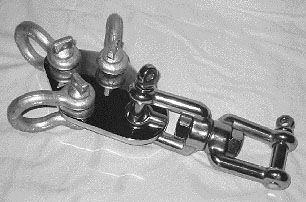
You don’t expect to read about novel products for offshore sailboats from a company in Arizona, but Colligo Engineering and Design in Mesa, AZ, has come up with something that’s worth a look. If you’re one of those boat owners who keeps his or her vessel in a distant port, unattended for long spans of time, you know how worry can creep into your life. One way to eliminate at least some of the worry is to install a device with built-in redundancy, something PS likes a lot when it comes to securing our vessels.
Colligo Engineering’s Mooring Bridle Plate—a half-inch-thick plate available in either stainless steel or hot-dipped galvanized—comes fitted with a stainless steel swivel (with a working load of 7,000 lbs.) and either two or three galvanized shackles sized at 5/8 inch attached to the plate.
The device was conceived by John Franta, a principal at Colligo, who keeps his boat in a small harbor on the Sea of Cortez in Mexico, hundreds of miles away. Franta found that his peace of mind was considerably enhanced after he installed the Mooring Bridle Plate.
The company fabricates two models, one for monohulls (two mooring line attachment points) and one for multihulls (with three; shown above).
The complete system includes the plate, the swivel, the shackles, either two or three 40′ lengths of 3/4″ nylon line (with stainless thimbles in the eyesplices at one end), and chafe guards. Prices run from $144.95 for the galvanized monohull version to $269.95 for the polished stainless steel multihull version.
PS tested this product for several months on a mooring in New England. It withstood several northeasterly storms, including one that produced a four-foot chop. We found it to be rugged and reliable, but we also noted several concerns.
The bridle plate is so substantial that it requires you have an appropriately sized mooring ball; it regularly pulled our 18-inch ball under in chop. (Admittedly, using the Mooring Bridle Plate for our 30-foot test boat was overkill.) And we suspect that this apparatus was the culprit when we rowed out to find that the bobstay (a stout length of 5/16 stainless, 1 x 19 wire) on our boat was signifcan’tly bent.
The other concern we noted was that the lines that accompany the Mooring Bridle Plate are overly long for our application. Those sailors who own boats smaller than 40′ would do well to specify slightly smaller diameter lines (and shorter ones, too) as these large lines are difficult to bend around standard sized horn cleats.
Despite those concerns, if you have the right size boat, and you want a little more peace of mind when you and your craft aren’t sharing the same time zone, the Mooring Bridle Plate would be a good investment. Of course, it bears restating that every mooring system is only as secure as its weakest link. Just because you’ve got this bulletproof device connecting your boat to the mooring doesn’t guarantee that the rest of the mooring system is sound.
Contact – Mooring Bridle Plate, 480/807-0237, www.colligoengineering.com.




































